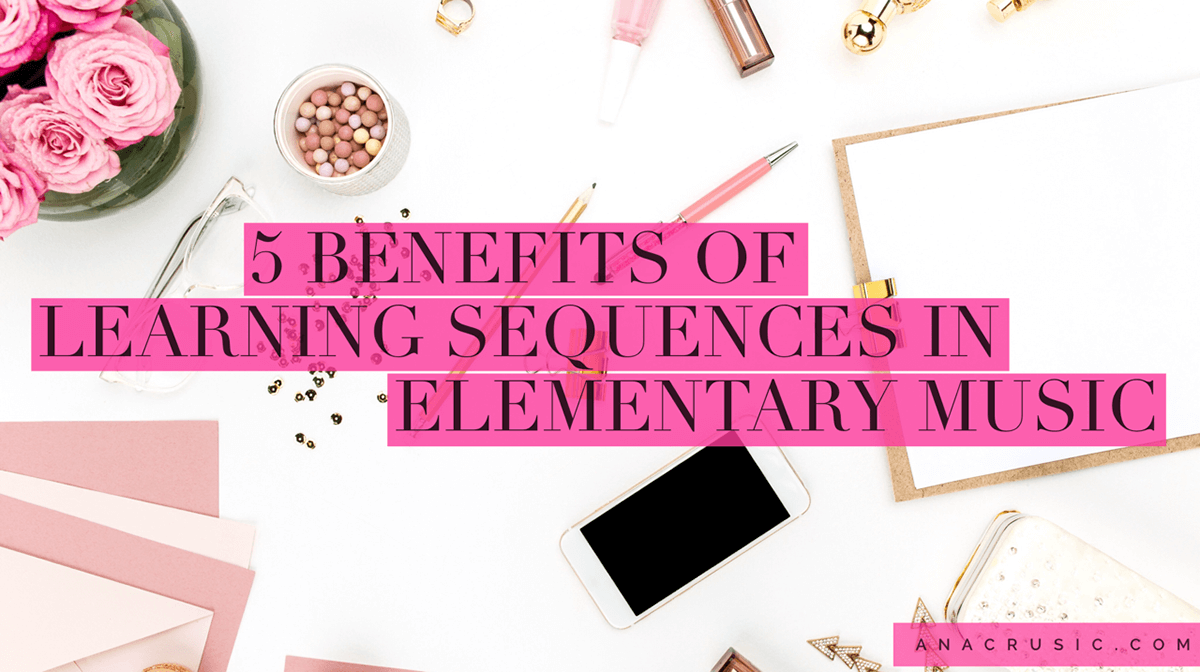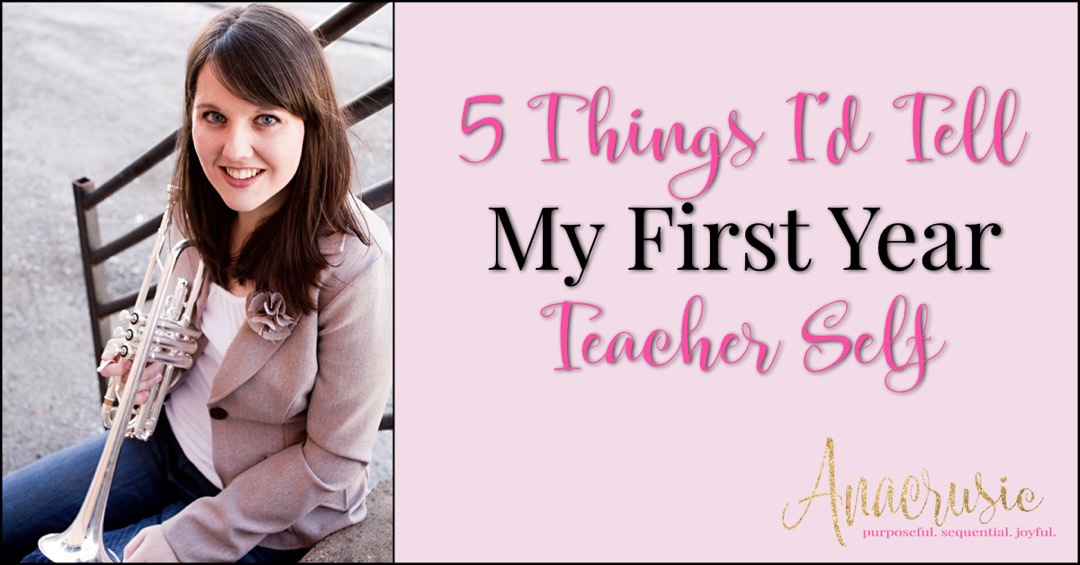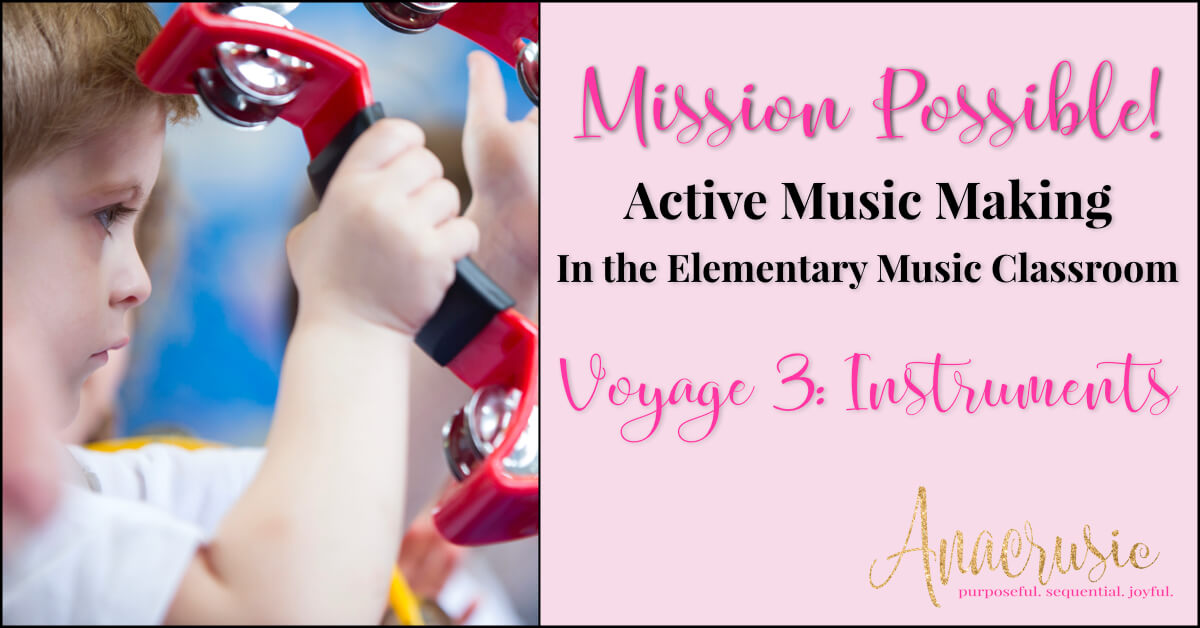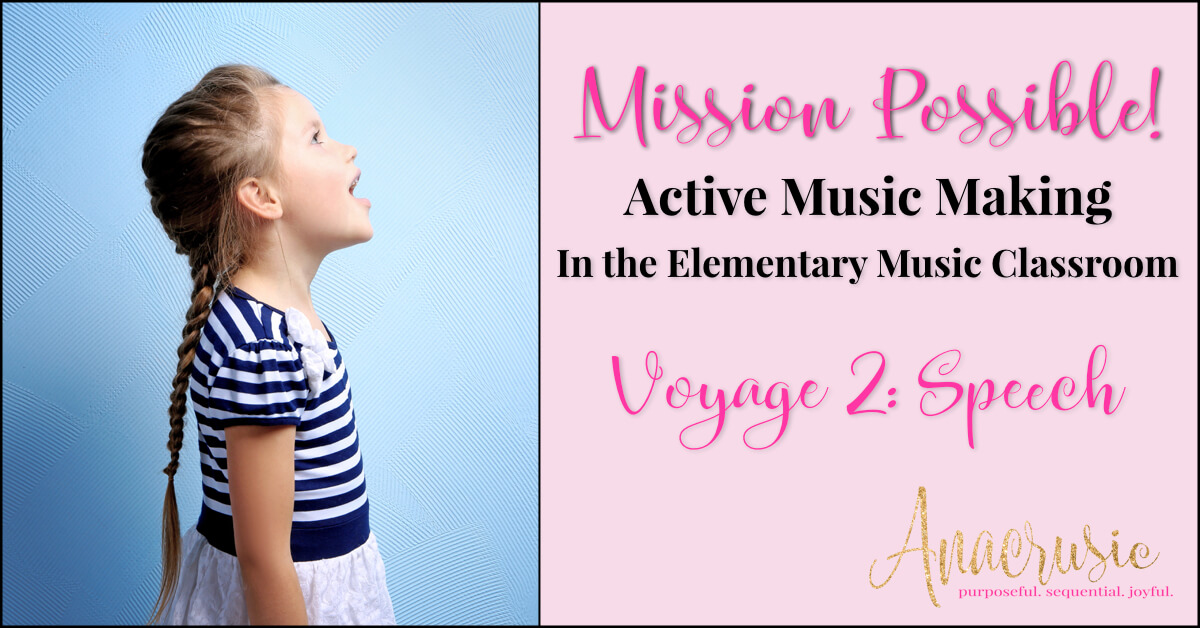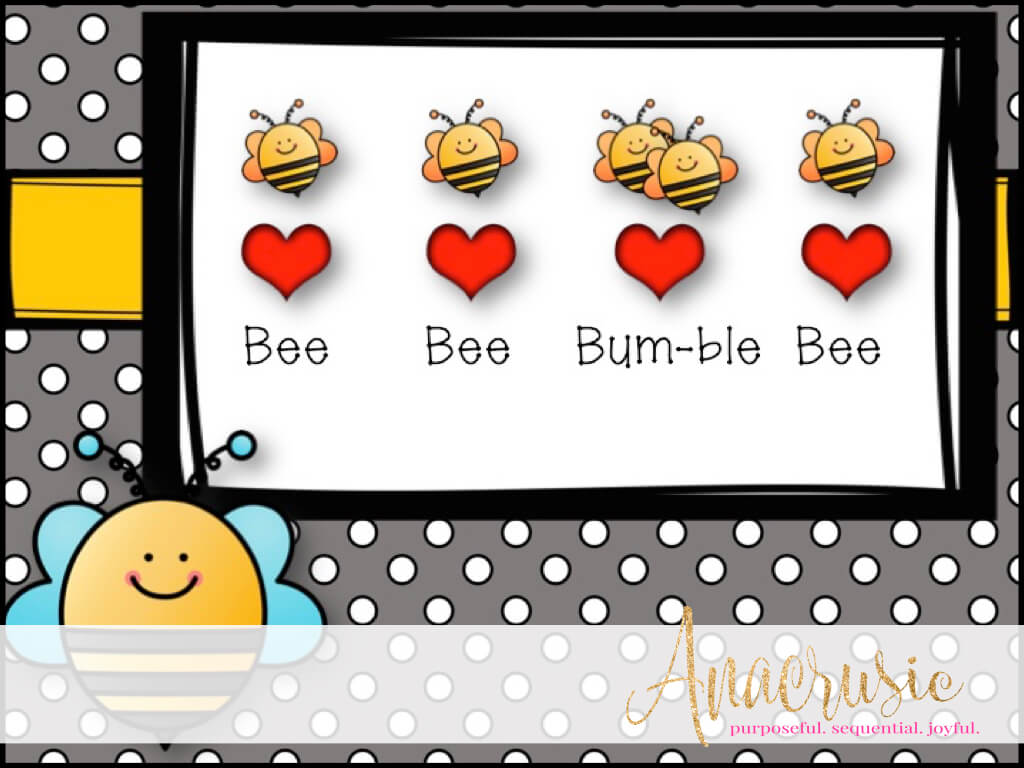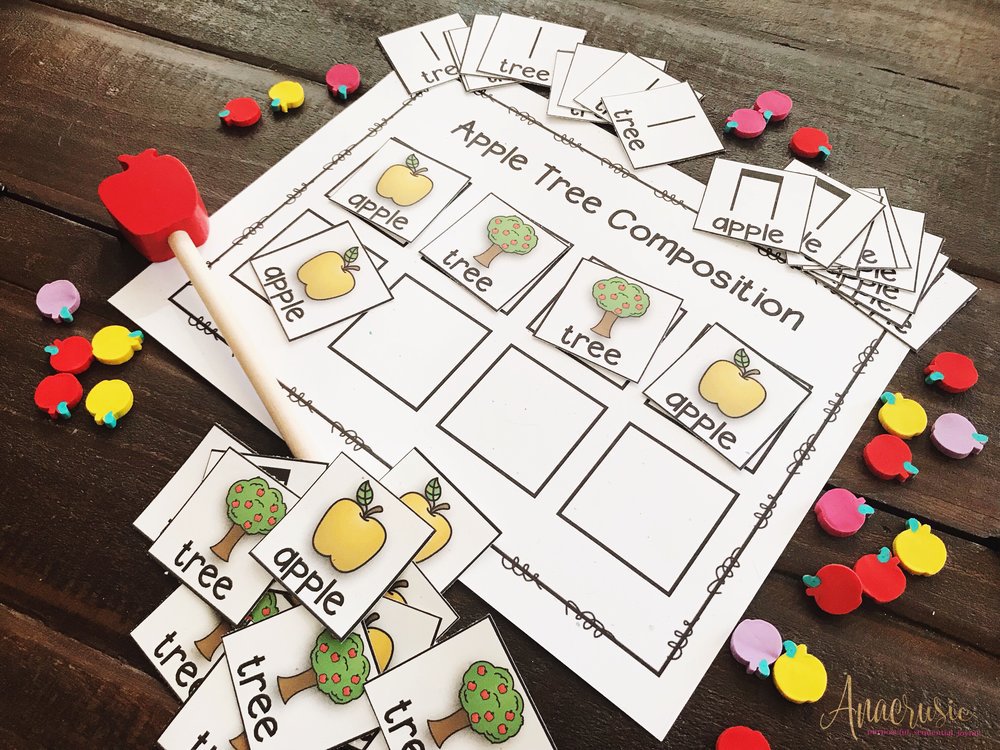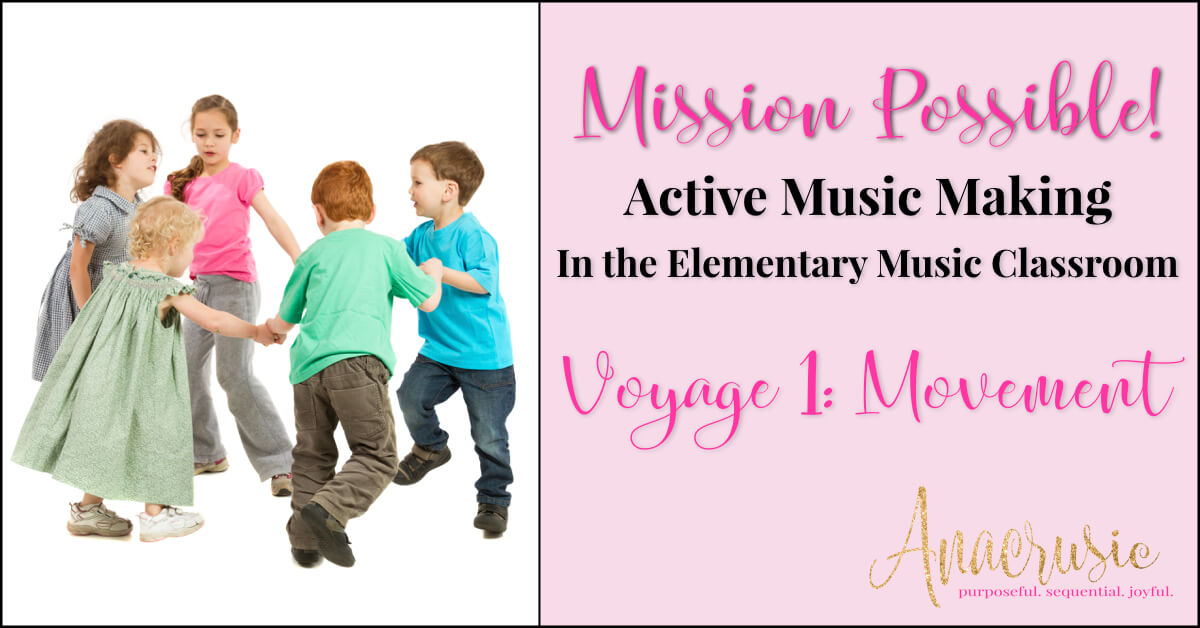5 Benefits of Learning Sequences in Elementary Music (+ What is a Learning Sequence?)
You’ve already figured out what to teach in what order, and how to layer concepts overall in your elementary music classroom. You have the scope, you have the sequence, you have the whole big picture, the macro sequence if you will. But what about when it gets to the nitty gritty of that concept. Do you feel like you have your learning sequences figured out on the micro level? If you haven’t even allowed your brain to go there, or you don’t feel 100% solid on how to lead your students through exploring, discovering, and owning a musical concept in the elementary music room, then buckle up kids.
I used to be exactly the same way. I’d make sure I got to quarter notes and eighth notes before I ever used a tie. I’d sing songs with so and mi and add la later on. But I never knew how to get into those concepts in a way that promoted literacy and fluency. And I didn’t feel like my kids were being their most musical selves. Until I started actively using learning sequences.
A learning sequence is a series of purposeful steps that facilitates your students’ exploration, discovery, extension, sharing & reflection of any given musical concept.
If you feel like, I don’t know what you’re talking about Anne, I’ve got all these teaching things in the bag, 100%! Well… just give me a hot minute. I get it. I felt the same way. I had my order of concepts. I knew which rhythmic and melodic concepts I needed to teach. I knew how to sequence concepts overall to create a spiral curriculum. But I also felt stuck. I didn’t know how to teach concepts in a way that would allow my students the opportunity to speak the musical language before I asked them to read it.
I know you’ve probably got a scope and sequence and you most likely know what to teach in this grade and the next grade and beyond. But I challenge you to take it one step further. Focusing on how you sequence each individual concept not only gives your students the tools they need to have total and complete ownership over a concept, but it clarifies your teaching process too. Still not sure? Let me explain.
Committing to learning sequences gives your teaching direction & purpose.
There are about a million and one ways to teach each and every concept. One day you might use this song, another day you might use this activity, but if you’re haphazardly piecing together activities and throwing a penny and making a wish that the kids just “get it,” the intention isn’t there. Working through a learning sequence for each concept not only helps to identify what to teach when, but how to teach it and why.
Planning learning sequences makes choosing what to teach easy as pie.
I’ve said it once, I’ll probably say it a million times… When you purposely choose to include activities in your music classroom, you’re effectively choosing to exclude something. You probably only see your kids once, maybe twice a week. Time is of the essence, and we have a lot of concepts to teach. Implementing learning sequences for each and every concept takes the guess work out of what to teach, and streamlines the decision making process for what goes where. You know how you want to facilitate student learning, and therefore have a greater sense of what repertoire and activities will serve them well.
Creating learning sequences identifies how students will best discover concepts.
Since there are so many different ways to explore & discover musical concepts, taking the time to identify how your students in your teaching scenario might best experience an element is an essential component of using learning sequences. The flexibility to determine the best way to reach your learners at any particular time is one of my absolute favorite parts of this process. The structure provides the fluidity to adapt and differentiate learning for all of your students.
Facilitating learning sequences promotes student ownership and agency.
It’s as simple as this: the more students are prepared and given quality musical experiences by which to play on the front end, the more ownership and agency they have on the back end. By purposefully planning learning sequences that give students the opportunity to explore and discovery concepts by being their most musical selves, we enable them to build upon those experiences and increase music fluency.
Implementing learning sequences puts your mind at ease.
Maybe the best part about learning sequences is that once you have a system, it’s completely plug & play. You pick the intention, work through the process, and create purposeful, sequential, and joyful musical experiences for your kids.
What to snag the how-to guide for teaching anything and everything with learning sequences?? Click here to grab it fo’ free!!
5 Things I’d Tell My First Year Teacher Self
There are about a million and one pieces of advice everyone spouts at you when you’re a first year teacher. Helpful hints about this curriculum, that activity, and the other classroom management plan you should definitely subscribe to that will magically fix your classroom. And while that’s all well and good, the things I would go back in time and tell myself has little to do with what curriculum or concept to use, and much more about how unexpected life as a first year teacher was. I was overcome with all of these changes, all these pattern shifts that I didn’t deal with well. Overtime, although these feelings haven’t gone away, I’ve found a few ways to cope and make things better.
Yep, there I am. Trumpet in hand, about to embark on a crazy journey I couldn’t even imagine. Here are some things I would tell myself, if I could turn back time. (I know you’re singing it in your head–I definitely am.)
1. You will be tired.
I mean, yes, if you move from college life (even student teaching) to teacher life, the shift hits you hard and fast. But it’s not just a “oh now I have to be at the place and do the things” kind of tired, but more like you have to run a marathon and then go home and get ready to do it all again tomorrow. Trust me, I’ve run a few half marathons in my day, and although that is exhausting, the new teacher tired is real.
This even hits “fill in the blank” year teachers. The shift from the summer back to the classroom and right into the first week leaves all of us dying to catch up. You will pour your heart and soul into your classroom and your students right out of the gate, no doubt wanting to be the best teacher you can be. And you shouldwant to be the best teacher you can be. But not to the detriment of your body being completely run down. It’s hard to catch up once you hit the ground running that first week of school—after the first week, there’s the second, and this event to plan for or that concert. It’s a lot.
And it’s not only prepping for the “big” things. The day to day as a music teacher is constantly up and moving. There is little to no down time, except for when you (maybe) get a few minutes to plan or eat lunch. Other than that, you see a lot of kids consistently each and every day. Every year when I step back into the classroom, I inevitably loose my voice and take a nap when I get home from work everyday.
All this to say, it’s the best kind of tired. You will pour your heart and soul into being the best that you can be, because you became a music teacher for all that you could give to your kids. Your body does get used to it, and you learn to manage your energy better.
What will help:
- Take a nap everyday. Seriously. Even if I didn’t go to sleep, I took about 30 minutes to sit in silence, close my eyes, and decompress the minute I got home from school my first year. The dishes can wait.
- DRINK WATER. It’s hard not to run on caffeine and sugar alone, and yes it’s hard to find time to run to the restroom, but reach for water as much as you can. Your body and your voice will thank you.
- Take some time to breathe. If you’re new here, this is something I say a lot. Taking the first 5 minutes of your already rushed planning time to sit in the silence seems counterintuitive, but giving yourself little breaks where you can throughout the day is invaluable for your state of mind.
2. You will be overwhelmed.
No matter what kind of first year teacher you are, there’s a lot. Likely lots of life changes, a new found sense of independence, a paycheck, a “real person” job, etc. And then aside from the fact that your whole world is just different, you’ve started this new job with all this stuff you have to do. And then, as a music teacher, that’s generally multiplied by the number of grades you have to teach.
You’ll write lesson plans for each and every grade, you’ll learn the standards and create assessments, and do the best to learn each and every child’s name in your classes—which is likely the whole entire school. That’s not to mention the performances, the extra stuff (choir, Orff ensembles, etc.), running the sound for the school assemblies, DJing field day, and whatever else falls under the umbrella of the music teacher at your campus.
Yes, it’s a lot of responsibility. Yes, you will be working with everyone—all the students, all the teachers, all the staff. But guys, you’ll be working with everyone. One of my favorite parts about being a music teacher is that I see every kid in the building, I work with every grade, and I am central to the community because of that. What an overwhelming, special, important job.
What will help:
- Assigned seats. Even if you want to be free and give kids agency, this is not the place to do it—at least in the beginning. Having assigned seats in your classroom puts you in control of behavior management and allows you to move kids around when you need, easily keep track of assessments, and most importantly, learn names.
- Find resources that already have a curriculum map or outline. Search blogs, Pinterest, Teachers Pay Teachers, subscribe to newsletters, and look for things like the Anacrusic Resource Library. Being a first year teacher now is so much different than when I first started out—most of these amazing online resources hadn’t even been created yet! Take advantage of them, that’s why they are there.
3. You will feel isolated.
I remember when I first started teaching, I was so stinking excited to have my own music classroom down at the end of the hall where no one would be walking by and my kids could make music freely without worrying about disturbing testing or the library or anyone else. As someone who loves sort of being under the radar anyway, it was seriously the cherry on top. But as the first weeks of school went on, I realized that my geographic location in the building was super indicative of how I felt as a member of the school.
Yes, like I mentioned above, being the music teacher is ah-mazing, because you get to work with everyone on the campus. And although you may be on a team with your art teacher or PE coaches, it can feel very lonely to be the only one. It doesn’t mean you are destined to be the lonely music teacher, it just means that since your network isn’t as built in at the campus level, you have to work a little harder to find your people.
What will help:
- Find your tribes: on campus, in your district, and even online. Yes, some of the music teacher Facebook Groups are a little overwhelming, but there are a few full of genuine people who want to share and help one another. #TAP Insiders, the group for The Anacrusic Podcast listeners, as well as The Music Crew Collaborative, are two great places to start to look for likeminded and friendly music teacher friends.
- Eat lunch in the staff lounge. Ok, this is a thing I never do on a daily basis, but at least two to three times a week, I try to eat with other teachers. This is important to build genuine relationships, not just exchange emails about the latest program practice.
- Be a team player. Do your best to work with people when it comes to changing rehearsal times, working on grade level programs, and any other interactions you might have with your staff. If the only experience colleagues have with you have been negative or difficult, it will only lead to you feeling more and more like you’re on an island.
4. You will second guess yourself.
If it’s your first year teaching or at a new campus, there are likely traditions and expectations and experiences that came before you that can be loved, or despised, or expected. Aside from that, everything is new. The kids, the lessons, and whatever systems your school has in place for discipline or otherwise will be totally unknown for the first couple of weeks. You are bound to make mistakes, have miscommunications, or need to ask questions as a first year teacher. Do not feel bad about any of it. You are strong, you are capable, and you were hired to make music with children. Aside from keeping them safe, that is your number one job. As long as you are doing that to the best of your ability, you are doing everything you’re supposed to.
What will help: Do the best you can with the information you have at the time. Let everything else go. End of story, period.
5. You will be overcome with joy, love, and purpose.
Yes, you will not feel this all the time. I mean, did you see the four previous things in this list? Embarking on this career path is not for the faint of heart. But what you put into teaching, you will get out of teaching. Remember that thing I said about pouring yourself into your kids? It might not happen straight away, but you will get all of that back ten fold.
What will help: Your job, the thing that pays your bills, the thing that you get to do each and every day, is make music with kids. Keep that at the forefront of everything you do.
Mission Possible! Voyage 4 – Singing in the Elementary Music Classroom
Well here we are, the final voyage on this very very possible mission. I hope by reading through the different posts this last month you are starting to realize that there are very real, very accessible steps you can take to begin adding active music making and different media to your music teaching. Your kiddos in your classroom deserve to have as many different options to be musical as possible, and to experience all of them fully so they can discover which media resonates with them most.
And you probably thought that singing was obvious. Or the after thought. But even though I’ve listed this guy last, I truly believe it should be the core of everything else you do.
Our voice is our first instrument. It provides the aural and kinesthetic understanding we need to literally internalize musical concepts and, perhaps more importantly, musical experiences. Without the ability to hear and produce sound (which is really what music is, if we want to oversimplify it), we are unable to truly understand and experience music to the extent that is required for mastery.
So this is not going to be a long and technical blog post. Rather, it’s going to be a quick bulleted list of ways you might consider using singing in the classroom, that perhaps you haven’t yet. Beyond the monkey see, monkey do, I’m going to sing because my neighbor is doing it so I kind of know what I’m doing… we’re going to dig a little bit deeper and really engage our children’s voice.
Solo Singing
This is the one that I think is tremendously underused in all elementary music classrooms. Often we use it only for assessing, which only contributes to some of the anxiety kiddos feel when asked to sing alone. Way back in the day before my podcast was a little more focused, I talked about different ways to use solo singing in the kindergarten classroom, but I think all of those applications apply no matter the grade.
Have students sing and sing often. Alone, together, for a game, to say hello, to say goodbye, however many different ways and in however many different situations have your kids start singing today. Because if you don’t start today, they won’t be willing tomorrow.
Patterning
This practice is probably most closely tied with Gordon’s Music Learning Theory. From my understanding, teachers who identify as MLT inspired use different tonal patterns to build up students’ musical vocabulary, and it takes place as an echoing practice, either individually or with a group. This is generally done on a neutral syllable, as to not interfere with the true essence of tonal relationships.
Although I personally do not subscribe to this type of pattern instruction, I have adapted some of the ideas of patterning into my own classroom. Particularly when exploring a melodic element, it’s important to create as many different contextual examples of that concept as possible. After all, re doesn’t exist on it’s own, it’s usually sandwiched in a descending or ascending pattern, or the question mark at the end of a phrase.
How do I use this idea in my classroom? One specific example is in my opening sequence. After my students have sung a couple of greeting songs, I take a quick moment to sing hello to them, either as a class or individually. They echo back “Hello Ms. Mileski” on the same pitches I sang to them. So if we’re working on a so-re turn, I might sing “hello third grade” in the pattern so-la-so-re. I try to find as many opportunities as possible to have students sing, particularly when it can contextualize an element we are preparing or practicing.
Improvisation
I think this word can be scary, especially when we are talking about singing. At least, it can be for me. Improvising with our voice takes an already very vulnerable thing, and makes it about 10 times more vulnerable. Singing is intimidating, improvisation is intimidating, and sandwiched together it could make your kids run for the hills. But like everything else, it’s all about how you go about it, how you introduce it, and how you make it a regular part of your music class. Improvisation doesn’t have to be using the blues scales to create a bridge to the third verse… or whatever your conservatory brained definition of improvisation is.
For kids, it simply means inspired singing. You can ask kids to sing questions, you can ask kids to sing about their weekend, you can ask kids to sing anything and it can be completely inspired in the moment. You can also be more formal about it as they become more comfortable. Take a tone set and write it on the board (I.e. mi-re-do). Then give them lots and lots of examples of what combinations of those three notes might sound like. And then let them practice.
If you find small entry points that are accessible and feel safe for your kids, you can begin expanding and scaffolding from that experience to build confidence and more independent musicianship.
For Joy
I feel like I could go ahead and just drop the mic right there. Do you really, and I mean really know any kids who don’t like to sing? I mean, maybe you have that fifth grader who just won’t open her mouth. But I bet when she was in Kindergarten, she loved to sing. I’m willing to bet that she’s a little nervous to do it now because she’s older, and she’s more aware of her surroundings and what people think, or had a bad experience when she tried the last time. The key to getting kids comfortable singing is to find ways that they love doing it. With accompaniment? Playing a game? With a dance? Pop music?
The point is, singing is a part of our life. Who doesn’t sing happy birthday? Or pick up a sleeping child and rock her to sleep while humming a lullaby? And those types of feelings and memories run deep for all of us, no matter our age. Sing with your kids. Sing joyfully with your kids. Everyday.
I hope you’ve enjoyed this series all about different forms of Active Music Making in the elementary music classroom. Just in case you missed a week, here’s a peek at the whole series:
- April 3: Introduction
- April 10: Voyage 1 – Movement
- April 17: Voyage 2 – Speech
- April 24: Voyage 3 – Instruments
- May 1: Voyage 4 – Singing (That’s today, y’all!)
Mission Possible! Voyage 3: Instruments in the Elementary Music Classroom
Here we are almost through the whole month of April and on the second half of the Active Music Making Series! I hope that you’ve found some inspiration through these different blog posts to incorporate new ways of using different media in your elementary music room.
Today, we’re talking all about instruments—barred, drums, unpitched percussion, anyway you’d like to hit it (pun intended). This post will not identify the different ways to teach an instrumental piece, as if you were to open up your Orff & Keetman Volumes and teach it like the conductor of the orchestra (which, arguably, is not necessarily the way they intended in the first place…) However, today I’m going to be talking about different ways to use instruments to enhance musical experience within the context of any given learning sequence.
Overt Curricular Content
When teaching rhythmic concepts, using instruments in the music classroom is a fairly literal way to teach a concept. Whether students are in the preparation phase of learning where they are only tapping the way the words go or can read formal notation, using drums and other unpitched percussion provides a new (and fairly motivating) medium by which to explore and practice rhythmic concepts.
But aside from teaching ta and ti-ti on a hand drum, there are other ways to use rhythmic instruments as visual, aural, and kinesthetic exploration for students in the music classroom. And for melodic concepts as well. There is no better visual for teaching steps, skips, the pentatone, and other tonal patterns that barred instruments. Even if you aren’t speaking in terms of absolute pitch, seeing and working with concrete objects that show spatial relationships is an extremely valuable differentiation.
How to use it? Perhaps if you are singing an echo song, have students play their so-mi part on the barred instruments. If you’re practicing steady beat with Kindergarten, have them play a steady beat on the instruments on an open fifth or an octave. There are ways to add instruments in early on even with your itty bitties to get them holding mallets early on.
Engagement
Have you ever played an elimination game where after one kid is out, and then another, and then another, the class seems to get more and more and more chaotic? Yup. Been there, played that game. (Okay, that pun wasn’t totally intentional, but I think you get the point!) The key to avoiding chaos, or at least channeling it into controlled chaos, is to have a relevant task for kids to do when they are eliminated. This also gets rid of the Debbie Downer attitude for that one kiddo who has his whole day ruined by being the first one “out.” Geez, you might even have kids fighting over who got out!
Here are the three different ways I use instruments with a game, either for elimination, or having just half the class play (super useful if you’re pulling double classes or have groups of 25+):
- Keep the beat. I’m assuming that whatever game you are playing has a song or rhyme that goes with it, so in that case, have the students who are eliminated or not part of the playing half of the class keep a steady beat. This does not have to be on an unpitched instrument! It can be, but if the song is pentatonic, you can have kids keep a simple drone on do & so.
- Play the rhythm. This works best on unpitched instruments, particularly with kindergarten and first grade students. If you’re having them practice beat vs. rhythm, switch what they have to play on the rhythm sticks, drums, etc. with each round of game play.
- Play an ostinato. This is most effective for students who are in second grade or above, but have them write a simple one to two measure speech ostinato and then play it on unpitched percussion instruments.
Note: if you have a super advanced class, you could totally have them play the melody or compose a melodic ostinato, but both of those take much more time and attention on your part, and is a pretty big project in and of itself. These activities are meant to be more spur of the moment to keep everyone engaged. They are also pretty awesome formative assessment opportunities!
Improvisation & Composition
These two late practice/extension activities are great instrument applications. Whether you are doing melodic improvisation and composition, sequencing from speech to instruments is a fantastic way to facilitate indpendent musicianship in the elementary music room.
I wrote about a full composition sequence here but to start out, have students create a simple ostinato to go with a familiar folk song or chant. It can be played on barred instruments or unpitched percussion. Give examples, try lots of different students’ ideas, and get your kids comfortable exploring with this media.
Large Scale Form
Last, but not least, you can use instruments to extend learning, to create a large scale form or class rondo. I often turn to instruments when I want to create a more impactful piece for students to share at a performance or for the ending of a unit. If kids are working on a speech piece, transfer it to instruments. If they are working on a body percussion piece, transfer it to hand drums. If they are working on a folk song, add a drone and a simple ostinato. Then find different combinations and patterns that you can use to create a unique musical experience for your kiddos… even if it’s from a folk song.
A Final Word…
I’m sure there are a few readers who are thinking, I could never do these types of activities with my kids. And maybe that’s true. Maybe you can’t do these types of activities… yet. It all goes back to developing rules and procedures so your kids know what to expect. Also, the more you find ways to use instruments (or any of the media in this series!) frequently in the classroom, the more they will become accustomed to “how music class works” with instrument activities, because it will be practiced. Everyone has to start somewhere, so find an accessible entry point and dive in!
Don’t look at instrument pieces or activities and books and think that you can’t use it just because you can’t use it as is. Everyone’s classroom is different, everyone’s kids are different, and so there is no one size fits all. If you are wanting to being using instruments in the classroom, find a simple way to start that seems accessible for your kiddos. Then slowly turn up the volume as time goes on. You don’t need to take things verbatim, just use the inspiration.
Here’s what’s coming up next! This series is all about giving you not only motivation, but tools and concrete steps to begin slowly releasing control and giving your students more agency in the elementary music classroom. Here’s a peek at what’s coming:
- April 3: Introduction
- April 10: Voyage 1 – Movement
- April 17: Voyage 2 – Speech
- April 24: Voyage 3 – Instruments (That’s today, y’all!)
- May 1: Voyage 4 – Singing
Get ready to activate your music classroom and stop simply covering concepts. We’re about to level up, friends!
Mission Possible! Voyage 2: Speech in the Elementary Music Classroom
Are y’all ready for stop number 2 on our Mission Possible? …or are you so over the cheesy title?? #sorrynotsorry
The good news for you is that out of the four different types of music teaching media we’re exploring this month, speech is definitely among the most accessible. I’m willing to bet that you already use poems and children’s literature in your classroom already, but perhaps these four applications for speech in the classroom will either help you think differently about how to use speech, or inspire you to expand upon how language is already used in your classroom.
Buckle up, it’s time for take off! (sorry, I just couldn’t help it…)
Learning a Song
There are many ways to teach a song (check out this blog post here), but one of my most favorite is to ask students for their own text suggestions when appropriate. This way you can provide lots of repetition by singing the song, but also promote student choice and engagement by adding in their words.
Two of my favorite folk songs for this is “Down Came a Lady” and “Great Big House in New Orleans.” For the first, the lyrics describe dresses of different colors, which is easily changed to a new color or pattern as students see fit. For the latter, whenever I teach it I ask students to tell me their favorite kind of pie. Usually every single hand is raised in the class! Sometimes I use some pictures to have students decide randomly what kind of pie they get to eat today. They loooove this game!
As another example, the Orff & Keetman Volumes are specifically designed to be “jumping off points” for teachers to adapt as they see fit in the music classroom. These elemental pieces are great for adding text, and text setting is often a focus in Orff-Schulwerk levels courses.
Rhythmic Learning
You’ve probably heard the phrase, “the rhythm is the way the words go.” …I sort of feel like I could just drop the mic right there. But seriously, that’s the essence of using rhythmic speech as a basis for rhythmic learning.
Particularly in lower elementary grades, I use rhymes and counting games all. the. time. The rhyme I use to present quarter note and paired eighth notes is “Bee Bee Bumble Bee.” Even if you are singing rather than speaking text, deriving rhythmic patterns always comes down to how many syllables on how many beats.
If you want to check out more about how I use speech to derive rhythmic concepts, check out my complete set for Bee Bee Bumble Bee here.
Improvisation and Composition
Just like speech can be the vehicle for presenting rhythmic concepts, it can also be the media by which you prepare, explore, practice, and extend concepts as well. I particularly like to prepare rhythmic concepts with speech improvisation and composition (which totally exists on a continuum, check out this post here), then transfer those speech patterns to formal notation after the new rhythm has been derived.
Speech can be used as the vehicle for all phases of rhythmic learning, not just the preparation phase. Better yet, it can serve as a jumping off point for transferring to body percussion and/or instruments. Using language as a scaffold with these activities is invaluable.
Free Improvisation
I love to use a poem or a story as an outline for free improvisation with my students, whether with movement or using instruments. In this type of activity, either myself or only one student might be reciting the poem, but the language serves as an inspiration point for adding unpitched percussion or movement in small groups.
If using unpitched percussion, perhaps choose a poem and underline certain words. As a class, decide on what soundscape would help paint an aural picture of whatever the describing word might be. Then, as the poem is recited, have students assigned to each of those soundscapes.
Similarly for movement, have students form small groups and be responsible for one line of a poem. If your kiddos have had lots of movement experiences and have vocabulary in their toolbox, they might be ready to just jump in with very few parameters. Sometimes it can be useful to put on some music without text for an activity like this, such as a circlesong.
Using free improvisation inspired by speech, regardless of the media, can be a really cool experience for both you and your children. It would also be a really neat way to incorporate language arts and make cross-curricular connections.
Here’s what’s coming up next! This series is all about giving you not only motivation, but tools and concrete steps to begin slowly releasing control and giving your students more agency in the elementary music classroom. Here’s a peek at what’s coming:
- April 3: Introduction
- April 10: Voyage 1 – Movement
- April 17: Voyage 2 – Speech (That’s today, y’all!)
- April 24: Voyage 3 – Instruments
- May 1: Voyage 4 – Singing
Get ready to activate your music classroom and stop simply covering concepts. We’re about to level up, friends!
Mission Possible! Voyage 1: Movement in the Elementary Music Classroom
For this series, I’m starting with movement because I think it presents the most barriers to those who are new to this way of teaching music. Using movement in my elementary classroom was very, very uncomfortable for me when I first began. It quite literally seemed like this completely different content area I had to teach in addition to all of my rhythmic and melodic elements. It was as I began to realize how inextricably tied movement is to other forms of music making that it became very natural in my teaching.
Way back in the day, (okay, just two years ago) I wrote this blog post about how to begin with movement in your classroom. This is quite literally for those of us who have felt so overwhelmed by the concept of using movement that they have no idea where to start. But today, we’re going to dive a little bit deeper into what movement in the elementary music classroom could look and most importantly feel like.
When considering how movement can be used in the music room, I’ve developed four different categories. This is how I decide what I am going to use movement for and why. Movement can be inspired by curricular content, used for vocabulary building, for overt music making, or to facilitate a holistically creative experience in and of itself. These categories do not always exist in isolation of one another, but rather can be combined and used in conjunction with one another depending on the experience you are facilitating for your students.
Vocabulary Building
When I think about vocabulary building within the context of a movement setting, I’m not necessarily referring to names and definitions. Although that is naturally part of the process, definitions have little to do with actual words to describe movement, but rather the actual movement experience in and of itself. Meaning, rather than having students describe what something is, they show and experience their own interpretation of the movement.
When I do a song like Frosty Weather, that already has a movement game built in, I think about different ways that I can alter or extend that game to include more vocabulary building. In this particular case, I’ll have students give me examples of different types of weather and a movement that go together (i.e. “sunny” & skipping) and then we’ll write a new verse as a class to go along with that student generated response.
This type of experience building and banking is all about taking student generated responses and using them as a jumping off point for vocabulary building through movement. If you’d like to see more of how I use Frosty Weather specifically for this purpose, check out the complete activity here.
Inspired by Curricular Content
As I look through my list of concepts within my entire scope and sequence, I am continuously looking for new ways to explore or extend any given element. Movement is such a wonderful way to deepen the scope of students’ experience, because it creates a broader scope of kinesthetic experience beyond clapping or using hand signs.
When thinking about rhythm concepts, I love to use locomotor movement as an additional reinforcer for sounds on a beat. That is, finding different motions through time and space that parallel what we might do within a rhythmic context. Particularly, “walk,” “tiptoe,” and “stretch” work incredibly well for quarter note, two eighth notes, and half note respectively. I love to do this just echoing patterns (I.e. walk, walk, tiptoe, walk for “ta, ta, ti-ti ta”) or to have students read rhythms in the extension phase.
Another great way to link movement to curricular content is having students create their own vocal pathways, and then turn them into movement pathways. You can have students set up different stations and create aural cues for moving from one pathway to the next. Comparative practice can also be very easily translated into movement terms— have students show high or low statues, move fast or slow, etc. Most of these work wonderfully as classroom warmups.
Check out how I use walk and tiptoe patterns with my kids in this activity.
Overt Music Making
What is so cool about using body percussion in the elementary music classroom is that It is aural, visual, and kinesthetic. That is, you can hear the rhythms and timbres, see the different levels, and feel it as a participant. It is also very easy to draw from speech and to other instruments. While Orff-Schulwerk is most commonly associated with body percussion, you don’t need to choreograph a piece of music from the Orff & Keetman volumes in order to effectively use it in your classroom. You can easily add an ostinato to an existing folk song or designate different rhythm elements as certain body percussion patterns while reading patterns (i.e. quarter notes = clapping, eighth notes = patting).
Taking on larger pieces are activities are much more accessible as you begin to add tiny pieces here and there in your normal music lessons. Body percussion is a great tool to add interest to known folk songs or simple octavos, as well as rounds and canons. This is a really cool example of different ways body percussion can be used.
Holistically Creative
Movement can be a musical experience in and of itself. Dalcroze Eurhythmics perhaps facilitates the most overt examples of how choreography can be inspired by or an inspiration for music. I truly believe that by exploring the other three categories of movement in the elementary music classroom, students can be led to experiences much like the example below.
I hope some of these ideas for using movement in the elementary general music classroom have inspired you to get out of your comfort zone and try something different in your classroom. It may surprise you and some of your students to find that they can be incredibly musical through movement.
Here’s what’s coming up next! This series is all about giving you not only motivation, but tools and concrete steps to begin slowly releasing control and giving your students more agency in the elementary music classroom. Here’s a peek at what’s coming:
- April 3: Introduction
- April 10: Voyage 1 – Movement (That’s today, y’all!)
- April 17: Voyage 2 – Speech
- April 24: Voyage 3 – Instruments
- May 1: Voyage 4 – Singing
Get ready to activate your music classroom and stop simply covering concepts. We’re about to level up, friends!
